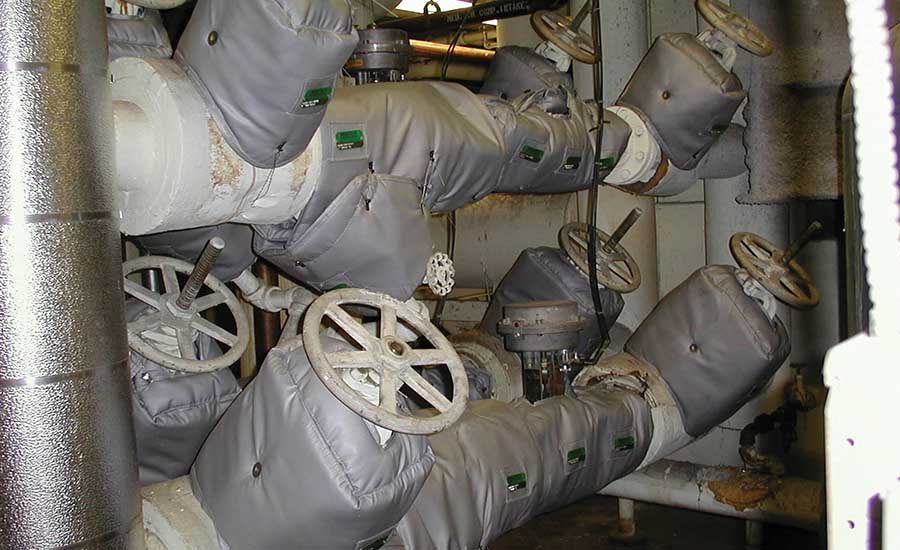One reliable way for energy managers and plant operators to reduce energy consumption is by installing insulation on steam lines. When carrying out routine maintenance, workers often remove this insulation. Experts, including the U.S. Department of Energy, say the key to long-term energy savings is developing a strategy employing reusable insulation.
The Energy Department’s Advanced Manufacturing Office suggests that plant and maintenance engineers “use removable insulation on components requiring periodic inspections and repair.” Done right, it’s a way to save millions of Btuh within less than a year while increasing safety and profitability.
For example, the Energy Department’s Advanced Manufacturing Office offers numerous calculations on its website. Installing “a one-inch thick blanket on an uninsulated six-inch gate valve in a 250-psig saturated steam line yields a savings of $525 per year.”
New construction generally has clean, white insulation on everything; it’s mitered and fully covered. However, experts note that much of this insulation isn’t easily removed. Industry professionals (including manufacturers and buyers of insulation) say that they rarely see construction documents specifying reusable insulation blankets for flanges and valves.
“Most insulation surveys address pipe and ignore the greatest opportunity: complex valves and fittings,” says Frank Kovacs, president of Shannon Enterprises of WNY Inc. “To correctly design and fit reusable insulation, a manufacturer needs an education in steam process systems and energy survey fundamentals.”
Experts say a proper audit is the key to knowing exactly where the energy savings and payback opportunities lie. It’s also important, say energy managers, to know how to compile the field data to present energy savings and get immediate approval from utility rebate programs if available.
Randy Haines, energy manager at Thomas Jefferson University in Philadelphia, says the primary reason he invested in reusable thermal insulation was for the payback. The university’s 4-million-sq-ft property, which includes one of the nation’s top health care learning institutions, buys its steam power from Veolia Energy at 175 lbs. The university reduces that to 60 lbs., 30 lbs., and even 15 lbs. for tasks such as space heating, sterilizing medical tools and red bag waste, and cooking.
“Buying steam can be pricier than making it yourself, so we’re always looking to reduce costs,” says Haines. “We hired an ESCO, an energy service company, to look at what kind of energy efficiency we could get. Part of their recommendation was to install reusable insulation blankets.”
Haines recalls that he had never heard of the concept of reusable blankets, but he was paying $25/1,000 lbs. for steam in 1999 when the ESCO delivered its findings. There was some skepticism, according to Haines, about anyone’s ability to design and size a reusable insulation blanket for something like a control valve.
The blankets promised a payback in less than a year if deployed across the university’s system, including pressure reducing valves and steam traps. As of 2017, Haines estimates he has approximately 1,000 Shannon INSULTECH® blankets in use across his system. Many of the blankets are among the original set installed nearly 20 years ago.
“Once installed, they fit like a suit,” remarks Haines. In part, Kovacs says, that is because his designs employ CAD, CNC design and manufacturing, and a library of prior blanket geometries to work from.
“Today, because of fracking, steam prices are around $13/1,000 lbs., so the payback for blankets bought today would be more like two years,” adds Haines. “But any payback in less than five years is worth it.”
Haines recalls other benefits to fully insulating his system include prolonging the life of equipment that’s no longer subject to high temperature radiant heat and improved safety for workers who don’t risk burns working near pipes and valves. When reducing heat in a mechanical room at other facilities where Kovacs deployed reusable insulation, he says data shows the approach lowered room temperatures in adjacent spaces by as much as 20°F.
“Removable and reusable insulation blankets are also a green concept,” says Tim Janos, director of special projects for the Association of Energy Engineers, “because maintenance workers will throw out insulation if it’s damaged or difficult to reinstall. I’ve seen reusable blankets in place for 30 years. Think of the energy saved from a $500 blanket over 30 years.”
“As long as you’re working with someone who understands the engineering and science inside and outside the system, then I can’t think of a reason not to insulate,” adds Janos.




